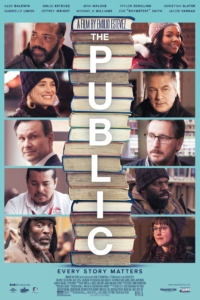 Kevin Finn, President/CEO, Strategies to End Homelessness
Kevin Finn, President/CEO, Strategies to End Homelessness
This weekend the movie, The Public, opened in theaters across the country and here in Cincinnati. The movie was filmed and set in Cincinnati. And tells a fictional story of the takeover of the downtown library by a group of homeless men during a brutal stretch of cold weather.
I’ve been working on issues related to homelessness locally for 21 years. So when I learned the movie was going to be made, I was concerned that the way people experiencing homelessness would be portrayed. That it would lead viewers to be less sympathetic, less concerned about the well-being of our homeless neighbors.
I was however encouraged when contacted by Emilio Estevez, the writer and director, for input on how to make this fictional work as realistic as possible. After providing some input, and two years later viewing the final product, I am satisfied with how The Public depicts those experiencing homelessness. And quite frankly I really like the movie, but that does not mean it was entirely accurate in how it represented the issue of homelessness.
Providing shelter in winter for the homeless
First and foremost, I have to point out the difference between the fictional situation portrayed in the movie (in which homeless shelter beds were all full or inaccessible) versus the local reality. In Greater Cincinnati, several organizations practically lift heaven and earth to make sure there are emergency shelter beds available for those who want one when it is bitter cold.
Specifically, Shelterhouse (which we help raise the funds needed to provide WinterShelter.org) the Emergency Shelter of Northern Kentucky, and Prince of Peace Lutheran Church go to great lengths to make sure there are warm beds available and accessible when temperatures drop.
Who is homeless in Cincinnati?
It is also important to understand that the characters in the movie are most representative of a certain sub-set of people experiencing homelessness, not of all homeless people. In the movie, the homeless people in the library are almost entirely male, and those who take control of a section of the library are all men.
In reality, our total homeless population (in shelter and unsheltered) in Hamilton County is about 40% female and 60% male. Now, when you look closer at only those people sleeping specifically on the streets, the group specifically portrayed in the movie, they are in fact more likely to be men. However, even among that population, about 70% are male and 30% female. Clearly women experiencing homelessness, and the unique challenges they face, are minimally represented in the film.
A word regarding one myth of homelessness that the movie touches upon, and also regarding something that is not well understood about homelessness that The Public does not attempt to address:
A common myth
The common myth is that most homeless people are in fact sleeping on the streets. In reality, 86% of people experiencing homelessness in Hamilton County sleep in a homeless shelter exclusively. Another 7% go back and forth between the streets and shelters, and the remaining 7% sleep exclusively on the streets or in places not meant for human habitation. Nationally, about 34% of homeless people are on the streets.
I mention this to highlight the exceptional work of our emergency shelter operators, who work not just during the winter but year-round to help people off of the streets, where they are more likely to encounter harm. Contrary to what a viewer might assume to be true about Cincinnati from watching the movie, we have fewer people sleeping unsheltered locally than most communities across the country.
A true reality: the number of homeless families and children is on the rise
What is not well understood about homelessness is the number of children, particularly children in families, who are homeless. It is regularly assumed that homeless people are in fact on the streets and that children are not homeless. It might surprise you to learn that in 2017 we had 72% more homeless children in Hamilton County (1,692) than we had people sleeping outside on the streets (979).
In short, a group of homeless people the general public assumes does not exist actually massively outnumber a group the general public assumes make up the majority of the homeless population. Unfortunately the number of homeless families and therefore children is on the rise.
The thing I am most pleasantly surprised by in The Public is the use of humor. I know that I speak for many who have experienced homelessness and those who go to work each day trying to end homelessness, when I say that humor is simply a part of the equation.
If a person can’t find a way to laugh at some of the ridiculous turns of bad luck or random bad circumstances that led to a person becoming homeless, they won’t be able to weather the storm. Or in the case of professionals working in the field, won’t be able to keep working on this issue for long.
Sometimes you have to be able to laugh at a situation before you can get to work changing it. And I thought The Public captured that reality very accurately.
Our thanks
I’m very encouraged by the attention the movie is bringing to the issue of homelessness, particularly in Cincinnati. And for that we are very grateful to everyone involved in making the film, particularly Mr. Estevez.